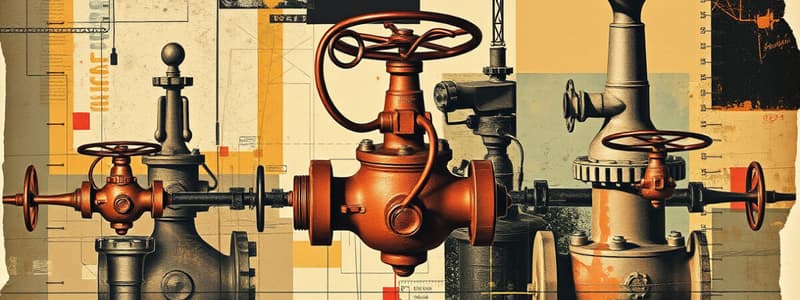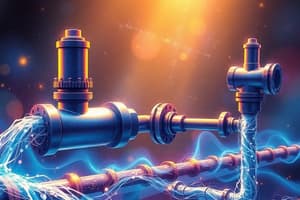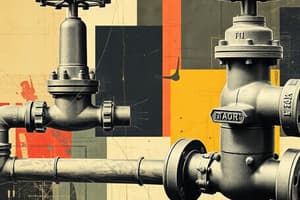Podcast
Questions and Answers
What is the primary function of control valves in a flow stream?
What is the primary function of control valves in a flow stream?
- To increase the temperature of the fluid passing through
- To shut down an entire system automatically
- To transform energy from one form to another
- To regulate the amount of material or energy in a process (correct)
In which service do control valves have only two positions: open and closed?
In which service do control valves have only two positions: open and closed?
- Divert service
- Throttling service
- Regulating service
- Shut-off service (correct)
Which type of valve is primarily used for throttling service?
Which type of valve is primarily used for throttling service?
- Butterfly Valve
- Gate Valve
- Globe Valve (correct)
- Check Valve
What characteristic is true for ball valves?
What characteristic is true for ball valves?
What is a common function of regulators in a water distribution system?
What is a common function of regulators in a water distribution system?
What distinguishes a spring-return actuator?
What distinguishes a spring-return actuator?
Which type of valve is commonly designed to prevent backflow?
Which type of valve is commonly designed to prevent backflow?
Which statement is true regarding butterfly valves?
Which statement is true regarding butterfly valves?
What is a characteristic of direct-acting valves?
What is a characteristic of direct-acting valves?
Which of the following is NOT an advantage of pneumatic systems?
Which of the following is NOT an advantage of pneumatic systems?
What limitation of pneumatic systems is primarily due to their reliance on compressed air?
What limitation of pneumatic systems is primarily due to their reliance on compressed air?
Why are pneumatic systems considered safe in inflammable environments?
Why are pneumatic systems considered safe in inflammable environments?
What is a common issue associated with the movement of pistons in pneumatic systems?
What is a common issue associated with the movement of pistons in pneumatic systems?
Which of the following accurately describes the design of pneumatic components?
Which of the following accurately describes the design of pneumatic components?
What could be a consequence of not processing compressed air before its use?
What could be a consequence of not processing compressed air before its use?
What effect does noise have in pneumatic systems?
What effect does noise have in pneumatic systems?
What are the primary levels in a pneumatic system?
What are the primary levels in a pneumatic system?
Which component is responsible for removing impurities from compressed air?
Which component is responsible for removing impurities from compressed air?
What is the main function of directional control valves in pneumatic systems?
What is the main function of directional control valves in pneumatic systems?
Which of the following is NOT a category of valves used in pneumatic systems?
Which of the following is NOT a category of valves used in pneumatic systems?
Which actuation method is NOT associated with directional control valves?
Which actuation method is NOT associated with directional control valves?
What role does the pressure regulator play in pneumatic systems?
What role does the pressure regulator play in pneumatic systems?
Which component is not part of the Air Service Unit?
Which component is not part of the Air Service Unit?
How are directional control valves commonly categorized?
How are directional control valves commonly categorized?
Flashcards are hidden until you start studying
Study Notes
Final Elements Overview
- Final elements regulate material or energy in processes through control signals.
- Control valves manipulate the flow of utilities like steam, air, and water in flow streams.
Types of Control Valves
- Shut-off Service: Two positional flow control that either allows or blocks flow.
- Divert Service: Two positional flow control that allows flow through different paths without blocking it.
- Throttling Service: Multiple positional control allowing precise regulation of flow rate.
Major Types of Instrument Valves
- Gate Valves: Enable full on/off service, ideal for isolation.
- Globe Valves: Primarily for throttling service with higher flow resistance.
- Check Valves: Prevent backflow, available in swing and lift designs.
- Ball Valves: Quick to operate, no lubrication necessary, suitable for on/off applications.
- Plug Valves: Evolved from tapered plugs, require lubrication for smooth operation.
- Butterfly Valves: Widely used for throttling due to their compact design.
Regulators
- Regulate water pressure in distribution systems to maintain supply.
- Pressure Regulator: Adjustable valve controlling downstream pressure.
- Spring-Loaded Pressure Regulator: Uses a diaphragm to sense pressure and adjust flow.
Actuators
- Provide motion to open/close valves, can be pneumatic, electrical, or hydraulic.
- Spring-Return Actuator: Uses internal spring for movement return.
Direct-Acting Valves
- Simple ON/OFF valves such as two-way solenoids that control process fluid flow.
Pneumatics
- Pneumatics utilizes compressed air for mechanical tasks and control.
- Advantages:
- High effectiveness in industrial settings.
- Durable and reliable components.
- Simple design eases integration.
- Adaptable in harsh environments.
- Safer to operate in flammable settings.
- Adjustable speed and pressure without pollutants.
- Economical components minimize costs.
- Limitations:
- Low accuracy due to dependency on compressed air volume.
- Limited to lighter loads.
- Requires processing of air to remove moisture and debris.
- Uneven piston speeds from air compressibility.
- Generates noise during operation.
Pneumatic System Structure
- Composed of:
- Energy Supply: Provides necessary power.
- Input Elements: Sensors detect system conditions.
- Processing Elements: Manage signals and data.
- Control Elements: Direct system operations.
- Power Components: Actuators that perform work.
Air Service Unit and Directional Valves
- Compressor: Compresses air, classified as reciprocating or rotary.
- Air Service Unit Functions:
- Preparing air for use.
- Filtering impurities from compressed air.
- Lubricating components for longevity.
Valves in Pneumatic Systems
- Control pressure and flow media; types include:
- Directional Control Valves: Manage air direction.
- Non-return Valves: Prevent backflow.
- Flow Control Valves: Regulate flow rate.
- Pressure Control Valves: Maintain desired pressure.
- Shut-off Valves: Stop flow when needed.
Characteristics of Directional Valves
- Described by:
- Number of ports (e.g., 2-way, 3-way).
- Positions available (e.g., 2-position, 3-position).
- Actuation methods (manual or mechanical).
- Return actuation methods (spring or air return).
Studying That Suits You
Use AI to generate personalized quizzes and flashcards to suit your learning preferences.




